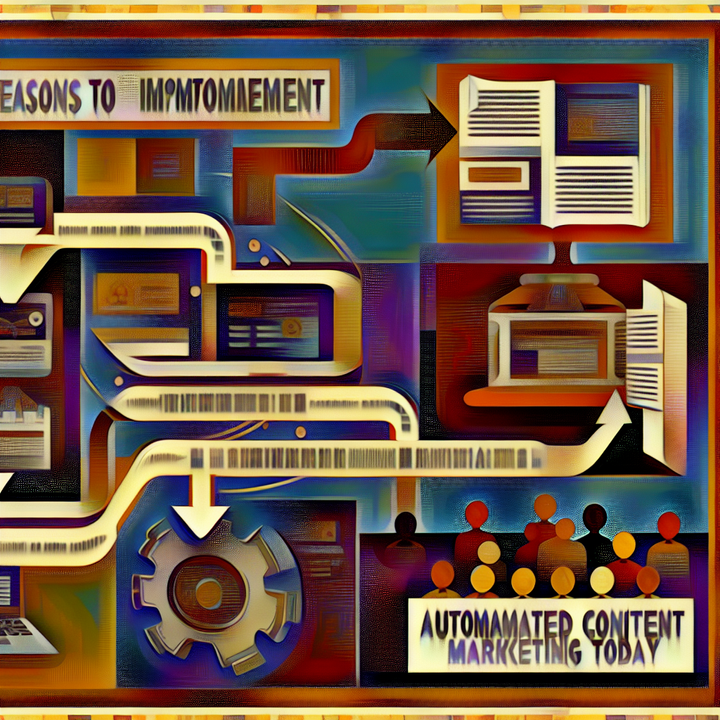5 Strategies to Increase Website Traffic with Automated Content

Understanding Automated Content: What It Is and Why It Matters
In the realm of digital marketing, automated content is emerging as a game-changer. In its essence, automated content refers to content that is created, published, and distributed with the assistance of artificial intelligence and machine learning technologies. This isn’t about replacing human creativity but rather enhancing and scaling it. As a result, it has significant implications for business owners, marketing managers, content strategists, and startup founders who are often stretched thin.
Studies show that companies using automated content solutions experience a marked improvement in both content output and engagement. For instance, a report from Accenture revealed that businesses employing AI-driven content strategies saw their content ROI increase by up to 30%. The key here is efficiency: automated tools can handle tedious tasks, freeing up human talent for strategic and creative endeavors.
Moreover, an automated content strategy can simplify the entire content creation process. In practice, this means:
- Reducing the time spent on drafting and editing content
- Ensuring a steady flow of fresh, relevant content without the usual bottlenecks
- Aligning content with SEO best practices to increase website traffic
Overall, the significance of automated content lies in its ability to streamline operations, maintain consistency, and enhance content quality, making it a cornerstone of modern digital marketing strategies.
Leveraging AI-Powered Tools for Content Generation
The landscape of content generation has been dramatically transformed by AI-powered tools. These tools are designed to automate various aspects of content creation, be it blog posts, newsletters, or social media updates. For businesses, the benefits extend beyond sheer convenience; it’s about delivering high-quality, SEO-optimized content that drives engagement and boosts traffic.
Some of the most effective AI tools for content generation include:
- GPT-3 by OpenAI: Known for generating human-like text, it can create everything from articles to creative copy.
- Jarvis: Specializes in writing blog posts and ad copy, saving hours of manual work.
- MarketMuse: Focuses on content optimization and keyword analysis to enhance SEO.
- Taleflow: Tailors content to a company's profile and target audience, ensuring both relevance and engagement.
One of the standout advantages of using AI-powered tools is their ability to produce content that is not only engaging but also SEO-friendly. By leveraging these tools, businesses can:
- Maintain a consistent posting schedule
- Ensure each piece of content is optimized for search engines
- Save valuable time and resources
In practical terms, this means more time to focus on strategy, analysis, and creative efforts—key elements that drive long-term success in content marketing.
Customizing Automated Content to Align with Your Brand Voice
Consistency in brand voice is crucial for establishing a strong brand identity. With automated content, the key to success lies in customization. Despite the automation, it’s possible to maintain a unique brand voice that resonates with your audience. Here’s how:
Firstly, set clear guidelines for your AI tools. This includes:
- Defining your brand’s tone (e.g., formal, casual, witty)
- Creating a style guide that outlines preferred terminology, themes, and formatting
- Providing sample content that exemplifies the desired voice and style
Once the parameters are set, AI tools can generate content that mirrors your brand’s personality. Regularly reviewing and tweaking these settings ensures ongoing alignment with your evolving brand voice.
Moreover, consider these additional strategies:
- Integrate brand-specific keywords and phrases into the content generation process
- Utilize feedback loops to refine and adjust the content style based on performance metrics
- Collaborate with human editors to infuse a personalized touch into the final output
Remember, the objective is to use automated content creation as a means to amplify, not replace, the unique elements that define your brand.
Optimizing Automated Content for SEO
SEO optimization is a fundamental aspect of content marketing, directly impacting your ability to increase website traffic. Automated content tools are equipped with capabilities to fine-tune content for search engines, ensuring higher visibility and better rankings.
Key SEO best practices include:
- Keyword Integration: Using relevant keywords strategically within the content.
- Meta Descriptions: Crafting compelling meta descriptions that improve click-through rates.
- Internal Linking: Linking to other relevant pages on your site to improve navigation and SEO.
- Alt Text for Images: Including descriptive text for images to enhance search engine indexing.
Automated content tools like Taleflow incorporate these practices seamlessly. For example, Taleflow's algorithms analyze and integrate high-performing keywords naturally within the content, ensuring it is both informative and aligned with search engine criteria. Furthermore, automated tools also manage technical SEO aspects, such as optimizing page load speeds and ensuring mobile responsiveness, which are critical for search engine rankings.
By leveraging these tools, businesses can ensure their content is consistently SEO-optimized without the tedious manual effort, ultimately driving more organic traffic to their websites.
Utilizing Analytics to Measure the Impact of Automated Content
In content marketing, performance tracking is essential to understand what works and what doesn’t. Automated content is no exception. By utilizing advanced analytics, businesses can gain insights into the effectiveness of their content strategies.
Important metrics to track include:
- Website Traffic: Monitor the amount of traffic your site receives and identify which content drives the most visitors.
- Engagement Rates: Measure how users interact with your content, such as time spent on page, shares, and comments.
- Conversion Rates: Track how many visitors take the desired action, such as signing up for a newsletter or making a purchase.
Taleflow’s analytical tools provide detailed reports on these metrics, offering insights that help refine and improve content marketing strategies. Businesses can utilize this data to:
- Identify high-performing content and replicate its success
- Adjust content topics and formats based on user preferences and behaviors
- Measure the return on investment (ROI) of their content efforts
Ultimately, analytics empower businesses to make data-driven decisions and optimize their automated content strategies for better performance and higher returns.
Integrating Automated Content into Your Overall Marketing Strategy
To maximize the benefits of automated content, it’s essential to integrate it into your broader marketing strategy. This holistic approach ensures coherence and amplifies the impact of your marketing efforts.
Consider these actionable steps:
- Align Content with Marketing Goals: Ensure that your automated content supports your overall marketing objectives, such as brand awareness, lead generation, or customer retention.
- Coordinate Across Channels: Use automated content to create a cohesive message across various marketing channels, including email campaigns, social media, and paid advertising.
- Leverage Automation for Personalization: Use AI tools to segment your audience and deliver personalized content, enhancing user experience and engagement.
- Monitor and Adjust: Continuously track performance and adjust your strategy based on analytics insights.
For example, a company might use Taleflow’s automated blog service to maintain a consistent blog schedule while simultaneously running personalized email campaigns using Taleflow’s newsletter automation features. This integrated approach ensures that all content efforts are aligned and reinforce each other.
Integrating automated content into your overall marketing strategy not only streamlines operations but also amplifies your marketing reach and effectiveness. By doing so, businesses can ensure that their content efforts drive meaningful results and contribute to their long-term success.



